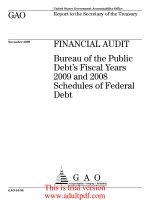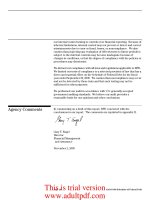United States Government Accountability Office GAO November 2010 Report to the Chairman, United States Securities and Exchange Commission|_part5 potx
Bạn đang xem bản rút gọn của tài liệu. Xem và tải ngay bản đầy đủ của tài liệu tại đây (251.7 KB, 10 trang )
Management’s Discussion and Analysis
TABLE 1.4
PERFORMANCE INDICATORS RESULTS SUMMARY
GOAL 1: Foster and Enforce Compliance with the Federal Securities Laws
OUTCOME 1.1: The SEC fosters compliance with the federal securities laws.
FY 2009
Actual
FY 2010
Actual
INDICATOR 1: Percentage of actions identi ed as “high impact” which have resulted in signi cant corrective
industry reaction
N/A 100%
INDICATOR 2: Annual increases or decreases in the number of CCOs attending CCOutreach programs N/A N/A
OUTCOME 1.2: The SEC promptly detects violations of the federal securities laws.
FY 2009
Actual
FY 2010
Actual
INDICATOR 3: Percentage of exams that identify de ciencies, and the percentage that result in a “signi cant nding”
Percentage identify de ciencies N/A 72%
Percentage that result in a “signi cant nding” N/A 42%
INDICATOR 4: Number of investigations or cause exams from tips:
Number of investigations N/A 303
Number of cause exams N/A N/A
OUTCOME 1.3: The SEC prosecutes violations of federal securities laws and holds violators accountable.
FY 2009
Actual
FY 2010
Actual
INDICATOR 5: SEC investigations referred to SROs or other state, federal, and foreign authorities for enforcement N/A 492
INDICATOR 6: Percent of all enforcement investigations deemed “high impact” N/A 3.26%
INDICATOR 7: Percent of investigations that come from internally-generated referrals or prospects N/A 21.9%
INDICATOR 8: Criminal investigations relating to SEC investigations N/A 139
INDICATOR 9: Disgorgement and penalties ordered and the amounts collected by the SEC:
Ordered amounts (in millions) $2,442 $2,846
Collected amounts (in millions) $1,683 $1,724
INDICATOR 10:
Requests from foreign authorities for SEC assistance and SEC requests for assistance from foreign authorities
Number of requests from foreign authorities 408 457
Number of SEC requests 774 605
GOAL 2: Establish an Effective Regulatory Environment
OUTCOME 2.1:
The SEC establishes and maintains a regulatory environment that promotes high-quality disclosure, nancial reporting
and governance, and that prevents abusive practices by registrants, nancial intermediaries, and other market participants.
FY 2009
Actual
FY 2010
Actual
INDICATOR 1: Average cost of capital in U.S. relative to the rest of the world N/A 10.99%
OUTCOME 2.2: The U.S. capital markets operate in a fair, ef cient, transparent and competitive manner, fostering capital
formation and useful innovation.
FY 2009
Actual
FY 2010
Actual
INDICATOR 2: Average quoted spread for exchange listed stocks on a monthly basis (in cents) N/A 2.52
INDICATOR 3: Average effective spread for exchange listed stocks on a monthly basis (in cents) N/A 2.65
INDICATOR 4: Speed of execution (in seconds) N/A 1.77
INDICATOR 5: Average quoted size of exchange listed stocks on a monthly basis N/A N/A
INDICATOR 6: Average daily volatility of exchange listed stocks on a monthly basis N/A 1.18%
OUTCOME 2.3: The SEC adopts and administers rules and regulations that enable market participants to understand clearly their
obligations under the securities laws.
FY 2009
Actual
FY 2010
Actual
INDICATOR 7: Percentage of SRO rule lings that are submitted for immediate effectiveness N/A 69%
N/A – Signi es data does not currently exist for existing or newly added measures
31
FY 2010 PERFORMANCE AND ACCOUNTABILITY REPORT
MANAGEMENT’S DISCUSSION AND ANALYSIS
Page 37 GAO-11-202 SEC's Financial Statements for Fiscal Years 2010 and 2009
This is trial version
www.adultpdf.com
Management’s Discussion and Analysis
Management Assurances
The SEC is rmly committed to building and maintaining strong internal controls. Internal control is an integral component of
effective agency management, providing reasonable assurance that the following objectives are being achieved: effectiveness
and ef ciency of operations, reliability of nancial reporting, and compliance with laws and regulations. The Federal Managers’
Financial Integrity Act of 1982 (FMFIA) requires agencies to annually assess and report on internal controls that protect the
integrity of federal programs and on the conformance of nancial management systems with certain requirements.
Guidance for implementing the FMFIA is provided through OMB Circular No. A-123. In addition to requiring agencies to provide
an assurance statement on the effectiveness of programmatic internal controls and nancial system conformance, the Circular
requires agencies to provide an assurance statement on the effectiveness of internal control over nancial reporting.
In addition, Section 963 of the Dodd-Frank Wall Street Reform and Consumer Protection Act (Public Law 111-203), signed into
law on July 21, 2010, describes the responsibility of SEC management to establish and maintain adequate internal controls and
procedures for nancial reporting. Dodd-Frank requires an annual nancial controls audit, an assessment of the effectiveness of
internal control, and an attestation by the Chairman and Chief Financial Of cer.
The following Assurance Statement is issued in accordance with the FMFIA, OMB Circular No. A-123 and Section 963 of
Dodd-Frank.
Annual Assurance Statement
Assurance Statement Under FMFIA: The management of the SEC is responsible for establishing and maintaining effective
internal control and nancial management systems that meet the objectives of the Federal Managers’ Financial Integrity
Act of 1982. In accordance with OMB Circular No. A-123, the SEC conducted its annual assessment of the effectiveness
of internal control. The results of this assessment identi ed two material weaknesses: one in information systems and a
second in the agency’s nancial reporting and accounting processes; this latter material weakness is the combination of
ve de ciencies in nancial reporting, budgetary resources, ling fees, disgorgement and penalty transactions, and required
supplementary information. Because of these material weaknesses, the SEC is able to provide a quali ed statement of
assurance that the internal controls and nancial management systems meet the objectives of FMFIA. Details to support this
quali ed statement of assurance appear in the section titled Material Weaknesses in Internal Control.
Assurance Statement On Internal Controls Over Financial Reporting: In accordance with Appendix A of OMB Circular No.
A-123, the SEC conducted an assessment of the effectiveness of internal control over nancial reporting, which includes
safeguarding of assets and compliance with applicable laws and regulations. Based on the results of this assessment, the
SEC identi ed two material weaknesses: one in information systems and a second in the agency’s nancial reporting and
accounting processes; this latter material weakness is the combination of ve de ciencies in nancial reporting, budgetary
resources, ling fees, disgorgement and penalty transactions, and required supplementary information. Because of these
material weaknesses, SEC management concludes that the agency’s internal controls over nancial reporting were not
effective as of September 30, 2010.
Mary Schapiro
Chairman
November 15, 2010
Kenneth A. Johnson
Chief Financial Of cer
November 15, 2010
Ke
nn
et
hA Joh
ns
on
32
FY 2010 PERFORMANCE AND ACCOUNTABILITY REPORT
MANAGEMENT’S DISCUSSION AND ANALYSIS
Page 38 GAO-11-202 SEC's Financial Statements for Fiscal Years 2010 and 2009
This is trial version
www.adultpdf.com
Management’s Discussion and Analysis
Management’s Responsibility for Internal Control
The Federal Managers’ Financial Integrity Act requires that the
head of the agency, based on the agency’s internal evalua-
tion, provide an annual Statement of Assurance on whether
the agency has met the requirements of FMFIA. OMB Circular
No. A-123, Management’s Responsibility for Internal Control,
implements the FMFIA and de nes management’s responsi-
bility
for internal control in federal agencies.
Section 2 of the FMFIA requires agencies to establish
internal control and nancial systems that provide reasonable
assurance that the following objectives are achieved:
Effective and ef cient operations,•
Compliance with applicable laws and regulations, and•
Reliability of nancial reporting.•
Section 4 of the FMFIA requires that agencies annually evaluate
and report on whether nancial management systems conform to
government-wide requirements. The SEC evaluated its nancial
management systems for the scal year ending September 30,
2010, in accordance with the Federal Financial Management
Improvement Act of 1996 (FFMIA) and OMB Circular No. A-127,
Financial Management Systems, as applicable.
Appendix A of OMB Circular
No.
A-123 requires the agency
head to provide a separate assurance statement on the
effectiveness of internal control over nancial reporting (ICFR),
in addition to the overall FMFIA assurance statement. The 2010
Annual Assurance Statement for FMFIA and ICFR is provided
on the preceding page. This report also provides a Summary
of Financial Statement Audits and Management Assurances
under the section entitled Other Accompanying Information,
as required by OMB Circular
No.
A-136, Financial Reporting
Requirements.
As part of the overall FMFIA assurance process, SEC
management assessed internal control at the entity level, as well
as at the process, transaction, and application level. To assess
the effectiveness of entity-level control, SEC management used
the Government Accountability Of ce’s (GAO) document titled
Internal Control Management and Evaluation Tool (GAO-01-
1008G) to de ne entity-level control objectives. Then, SEC
management identi ed control activities performed by staff
across the SEC that address the control objectives. Information
on these entity-level control activities was gathered through
meetings with relevant points of contact and feedback in the
form of survey responses from SEC supervisors.
The effectiveness of process-level controls was assessed
through detailed test procedures related to the agency’s
nancial reporting objectives. As part of this effort, the agency
performed a comprehensive risk assessment in which SEC
management identi ed:
Signi cant nancial reports and materiality;•
Signi cant line items, accounts, disclosures, and laws •
and regulations;
Major classes of transactions;•
Relevant assertions, risks of material misstatement and •
control objectives;
Reporting and regulatory requirements; and•
Existing de ciencies and corrective action plans.•
From the results of the risk assessment, SEC management
documented business processes and control activities
designed to mitigate signi cant nancial reporting and
compliance risks. These control activities were tested for
design and operating effectiveness. The test results served as
a basis for management’s assessment of the effectiveness of
internal control over nancial reporting.
In addition, each division director and of ce head provided an
assurance statement identifying any management challenges.
These statements were based on information gathered from
various sources including, among other things:
Internal management reviews, self-assessments, and •
tests of internal controls as described above;
Management’s personal knowledge gained from daily •
operations;
Reports from the GAO and the SEC’s Of ce of Inspector •
General (OIG);
Reviews of nancial management systems under OMB •
Circular No. A-127, Financial Management Systems;
Annual performance plans and reports pursuant to the •
Federal Information Security Management Act (FISMA)
and OMB Circular No. A-130, Management of Federal
Information Resources;
Annual reviews and reports pursuant to the Improper •
Payments Information Act;
33
FY 2010 PERFORMANCE AND ACCOUNTABILITY REPORT
MANAGEMENT’S DISCUSSION AND ANALYSIS
Page 39 GAO-11-202 SEC's Financial Statements for Fiscal Years 2010 and 2009
This is trial version
www.adultpdf.com
Management’s Discussion and Analysis
Reports and other information from Congress or agencies •
such as OMB, the Of ce of Personnel Management
(OPM), or the General Services Administration (GSA)
re ecting the adequacy of internal controls; and
Additional reviews relating to a division or of ce’s opera-•
tions, including those discussed in the Other Reviews
section below.
Each year, the agency’s Financial Management Oversight
Committee (FMOC) evaluates the assurance statements
from directors and of ce heads, recommendations from OIG,
and other supplemental sources of information. Based on
this review, the FMOC advises the Chairman as to whether
the SEC had any de ciencies in internal control or nancial
system design signi cant enough to be reported as a material
weakness or non-conformance.
Other Reviews
GAO audited the SEC’s nancial statements. The objective
of GAO’s audit was to express an opinion on the nancial
statements and on internal control over nancial reporting
and to report on tests of compliance with selected laws and
regulations.
The OIG conducted 13 audits and reviews during the scal
year. The reviews covered 14 of the 33 assessable units (42
percent). Some components had multiple reviews.
Material Weaknesses in Internal Control
Information Systems. For FY 2009, the SEC reported infor-
mation security as one of six signi cant de ciencies which
collectively represented a material weakness in internal
control. Although the SEC undertook corrective actions in
FY 2010, the SEC continues to have pervasive information
technology and security control de ciencies which span
across its general support system and all key applications.
New security control de ciencies identi ed during the SEC
FY 2010 assessment include an inconsistent patch manage-
ment program, informal processes to ensure secure baseline
system con gurations, gaps in user access controls, and
untimely remediation of self-identi ed information security
control de ciencies. Because of these de ciencies, the SEC
cannot rely upon automated controls across its nancial
applications. These security de ciencies are heightened
because some of the agency’s nancial reporting processes
are reliant on databases and spreadsheets, which are inher-
ently less secure.
A material weakness is a de ciency, or combination of
de ciencies, in internal control, such that there is a reasonable
possibility that a material misstatement of the SEC’s nancial
statements will not be prevented, or detected and corrected on
a timely basis. Information systems are integral to the nancial
reporting process. Therefore, the SEC has determined that
the conditions noted above related to information
systems
meet the de nition of a material weakness since a reasonable
possibility exists that a material misstatement would not be
prevented, or detected and corrected on a timely basis.
Financial Reporting and Accounting Processes. The SEC’s
second material weakness stems from the agency’s reliance
on manual processes for nancial reporting and accounting,
many of which are necessary because of gaps in the agency’s
core nancial system. In several areas, these manual processes
are not operating effectively, because they are prone to error
and because the agency’s monitoring does not always detect
the errors. This material weakness relates to the combination
of ve de ciencies in the areas of nancial reporting, budgetary
resources, ling fees, disgorgement and penalty transactions,
and required supplementary information.
Financial Reporting. This de ciency is similar in nature to
the ndings from the FY 2009 nancial audit. In FY 2010,
the SEC launched efforts to enhance its tracking of
investments and formalized processes for evaluating
prior period adjustments and capturing contingent lia-
bilities. However, the agency has continuing gaps in the
functionality of its core nancial system, and therefore
many of the agency’s nancial reporting processes still
are manual in nature and reliant on spreadsheets and
databases to both initiate transactions and perform key
control functions. The FY 2010 assessments of internal
controls over nancial reporting continued to nd errors
in the agency’s nancial reporting processes, including
in reviews of calculations and reconciliations; in the
preparation, review and approval of journal voucher
adjustments; and in draft nancial statement notes.
The SEC also identi ed the need for additional external
validation points within its spreadsheets and databases
to ensure that manual compensating controls are oper-
ating effectively.
34
FY 2010 PERFORMANCE AND ACCOUNTABILITY REPORT
MANAGEMENT’S DISCUSSION AND ANALYSIS
Page 40 GAO-11-202 SEC's Financial Statements for Fiscal Years 2010 and 2009
This is trial version
www.adultpdf.com
Management’s Discussion and Analysis
Budgetary Resources. This area was found to be a sig-
ni cant de ciency in FY 2009, and in response the SEC
corrected posting models and developed new policies
and procedures related to posting obligations, creating
miscellaneous obligating documents, and processing
deobligations. However, the agency’s FY 2010 assess-
ment of internal controls over nancial reporting found
continuing problems, speci cally in the design and
operation of controls to:
Record obligations and adjustments to obligations •
accurately and on a timely basis, upon contract
execution;
Ensure completeness of recorded obligations between •
the core nancial reporting and sub-ledger systems;
Certify funds availability prior to the period of perfor-•
mance;
Ensure that open obligations identi ed by the divi-•
sions and of ces as no longer needed are timely
de-obligated by the contracting of cer per the close-
out procedures contained in Federal Acquisition
Regulation.
The conditions described above increase the likelihood
that obligation and adjustment transactions and bal-
ances could be misstated and not detected by SEC
management in a timely manner.
Registrant Deposits and Filing Fees. In FY 2009, the SEC
reported a signi cant de ciency over registrant deposits
and ling fees, because the SEC was not ensuring that
revenues were recorded on a timely basis and because
the agency had a backlog of inactive accounts for
which the balances should be returned to registrants in
accordance with SEC regulations. In FY 2010, the SEC
hired an outside vendor to assist with the process of
returning these funds, and the agency is currently in the
process of adding staff positions dedicated to the review
of current lings and dormant registrant deposit accounts.
However, as of September 30, 2010, the agency did not
yet have suf cient control activities in place to routinely
review, research, and monitor registrant deposit account
activity to determine if amounts should be refunded or
recognized as revenue.
Disgorgement and Penalty Transactions. The SEC collects
disgorgement and penalty amounts from violators of
securities law for subsequent distribution to harmed
investors. As part of the FY 2010 audit, the agency was
found to have insuf cient control procedures to ensure
that receivables and payments related to disgorgements
and penalties are recorded in the proper accounting
period. For example, the agency’s external auditor noted
that checks received on September 30 were not recorded
in the general ledger until the following day and therefore
were not recognized in FY 2010 for year-end reporting.
The SEC failed to record on a timely basis disgorgement
receivables that were initially payable to a court but then
were changed to be payable to the Treasury General
Fund through a subsequent court order. Although all
funds identi ed for transfer to the Treasury General Fund
were properly and accurately transferred as of September
30, 2010, some amounts collected on behalf of the U.S.
Treasury during the scal year were not transferred in a
timely manner.
Required Supplementary Information. OMB Circular No.
A-136 requires that agencies produce required supple-
mentary information (RSI) in their nancial statements, to
disaggregate budgetary information for each major bud-
get account. The agency’s external auditors found that
the SEC had not included RSI, particularly with respect
to the new Investor Protection Fund, in its draft nancial
statements. The SEC must ensure that its processes for
preparing nancial statements and notes properly re ect
the requirements of OMB guidance.
Corrective Action Plans
The core of the SEC’s strategy for remediating these material
weaknesses is to launch a major new initiative to replace the
agency’s core nancial system, by migrating to a federal gov-
ernment Shared Service Provider (SSP). This effort will help
address the agency’s material weakness in information sys-
tems reported for FY 2010 by moving the agency’s nancial
and secondary mixed nancial systems into a strong, proven
security environment. In addition, through this initiative, the
SEC will aim to eliminate many of its manual processes that
rely on Microsoft Access databases and spreadsheets and
consolidate them within the new SSP environment. The
SEC has issued a Letter of Intent with the Enterprise Ser-
35
FY 2010 PERFORMANCE AND ACCOUNTABILITY REPORT
MANAGEMENT’S DISCUSSION AND ANALYSIS
Page 41 GAO-11-202 SEC's Financial Statements for Fiscal Years 2010 and 2009
This is trial version
www.adultpdf.com
Management’s Discussion and Analysis
vices Center (ESC) at the Department of Transportation to
develop detailed requirements for the system, and is planning
to migrate to the new environment in FY 2012. The agency
also has strengthened its management team by hiring a new
Chief Operating Of cer, Chief Information Of cer, and Chief
Financial Of cer, as well as seeking to appoint a new Chief
Accounting Of cer.
While the SSP initiative is in progress, during FY 2011, the SEC
will continue to implement improvements in its information
security environment. For example, the agency will improve
its monitoring capability over system con guration changes,
so that all changes to system requirements, design, and
scripts are evaluated by a Con guration Control Board on the
basis of cost, bene ts, and risk to the agency. Future system
upgrades will be documented to show both the impact on
security and evidence of approval by the Board. The agency
also will work to certify the technical team managing the core
nancial application as Capability Maturity Model Integration
(CMMI) Level 3, to ensure that the system is managed to
strict con guration management standards. During the rst
quarter of FY 2011, the Of ce of Information Technology (OIT)
will update patches all across the agency’s nancial systems
and workstations and will enable Secure Sockets Layer (SSL)
communication protocol to ensure sensitive EDGAR data
is transmitted using a secure, approved communications
method. OIT also will work to resolve outstanding security
weaknesses in its systems identi ed by management through
its certi cations and accreditations.
Major improvements in the SEC’s nancial reporting pro-
cesses will be affected through the SSP initiative described
above. During FY 2011 before the agency migrates to the
SSP environment, the SEC will reduce the number of manual
processes by tracking investments at the detail level within the
nancial system and building an automated interface with the
Bureau of Public Debt for handling investments. In addition,
the agency will seek in the short term to bolster the databases
and spreadsheets still in use, for example by incorporating
the use of independent, external data sources wherever pos-
sible as validation tools.
The agency’s controls over budgetary resources will be sig-
ni cantly enhanced through integration of procurement and
nancial systems, which the agency aims to achieve as part of
the migration to a federal Shared Services Provider. In addi-
tion, in FY 2011 the SEC will continue to re ne its business
processes in this area, including by further enhancing the pro-
cesses by which the agency records miscellaneous obligating
documents and deobligates unliquidated amounts from prior
year contracts.
In FY 2011, the SEC will continue its efforts to resolve the
backlog of ling fees in need of veri cation and inactive deposit
accounts that must be returned to registrants. In addition,
the agency will work to re-engineer this business process and
plan for a new automated solution to replace Fee Momentum.
With continued remediation efforts, the SEC intends to ensure
that registrant lings and deposits are matched on a timely
basis, record revenues in the period earned, and eliminate the
backlog of dormant registrant deposit accounts.
Effective October 2010, the SEC modernized the cash receipt
process by electronically scanning checks upon receipt.
The scanned checks are recorded in the general ledger
through an automated interface. The SEC will establish a
process for recording deposits in transit to ensure all checks
received are recognized in the proper accounting period.
In addition, the SEC is working to enhance processes for
timely recognition of disgorgement and penalty receivables
deemed payable to the Treasury General Fund. In FY 2011,
the SEC will make any adjustments necessary to ensure these
enhanced processes and controls are operating effectively.
The SEC’s draft nancial reporting results did not include
required supplementary information, however, SEC ultimately
prepared the required supplementary information for the
September 30, 2010 nancial reporting. In addition, the SEC
will focus on performing a detailed review of OMB Circular
No.
A-136 and other relevant guidance to ensure that such
requirements are properly re ected in the agency’s nancial
statements.
Status of Prior Year Internal Control
over Financial Reporting Issues
The SEC’s FY 2009 nancial audit identi ed a material
weakness in internal controls over nancial reporting, that
resulted from the combination of six signi cant de ciencies:
Information Security,•
Financial Reporting,•
Budgetary Resources,•
36
FY 2010 PERFORMANCE AND ACCOUNTABILITY REPORT
MANAGEMENT’S DISCUSSION AND ANALYSIS
Page 42 GAO-11-202 SEC's Financial Statements for Fiscal Years 2010 and 2009
This is trial version
www.adultpdf.com
Management’s Discussion and Analysis
Registrant Deposits, •
Risk Assessment and Monitoring, and •
Fund Balance with Treasury.•
The rst area, information security was reassessed as a mate-
rial weakness in information systems for FY 2010. Prior year
signi cant de ciencies related to nancial reporting, budgetary
resources, and registrant deposits remain and, combined with
de ciencies related to disgorgement and penalty transactions
and required supplementary information, together remain a
material weakness. The agency initiated efforts to address
last year’s audit ndings, and successfully remediated two of
the six signi cant de ciencies disclosed in the FY 2009 PAR,
related to risk assessment and monitoring and the SEC’s
FBWT. The agency’s efforts to remediate these two areas is
described further below.
Risk Assessment and Monitoring Process
As mentioned above, the SEC’s external auditor cited
de ciencies in internal control monitoring as a contributing
factor to the agency’s second material weakness related to
nancial reporting and accounting processes. However,
the SEC’s efforts to improve its risk assessment process
during FY 2010 resulted in the remediation of this signi cant
de ciency. The SEC, with the assistance of contractor
support, implemented a top-down, risk-based approach for
FY 2010 and thereafter to:
Identify all key elements of the SEC’s nancial reporting •
control environment and evaluate all signi cant nancial
reporting and compliance risks, including those related to
its information systems and external service providers;
Document internal controls designed to mitigate nancial •
reporting risks, including client control considerations
identi ed in service organization SAS 70 reports;
Document the evaluation of design effectiveness of key •
internal controls and monitor the effectiveness of internal
controls throughout the year;
Perform test work to assess the operational effectiveness •
of internal controls;
Develop corrective action plans for internal controls not •
properly designed or operating effectively;
Assess the magnitude of internal control de ciencies and •
determined impact on the Statement of Assurance under
FMFIA
OFM will continue to perform a robust internal control assess-
ment in FY 2011, and plans to implement improvements that
will help to effectively manage, track, monitor, and test key risks
and controls over nancial reporting throughout the year.
Fund Balance with Treasury
In FY 2010, the SEC successfully resolved its previous signi -
cant de ciency over the reconciliations of its FBWT. Whereas
previously this monthly reconciliation was an ancillary duty
for OFM staff, the SEC created a new Treasury Operations
Branch within the Of ce of Financial Management with per-
sonnel dedicated to this function. SEC staff re-engineered
the reconciliation processes to be fully compliant with the
Treasury Financial Manual, developed new standard operat-
ing procedures, and automated the reconciliations to reduce
input errors and streamline the effort. The agency also fully
resolved the backlog of differences with Treasury records and
is now compliant with the policy to resolve variances within
60 days.
Financial Management System Conformance
The FFMIA requires that each agency shall implement
and maintain nancial management systems that comply
substantially with federal nancial management systems
requirements, applicable federal accounting standards, and
the U.S. Standard General Ledger at the transaction level.
The purpose of the FFMIA is to advance federal nancial
management by ensuring that nancial management systems
provide accurate, reliable, and timely nancial management
information. Although the SEC is exempt from the requirement
to determine substantial compliance with FFMIA, the agency
assesses its nancial management systems annually for
conformance with the requirements of OMB Circular No.
A-127 and other federal nancial system requirements.
The SEC’s process for assessing its nancial management
systems is in compliance with the January 9, 2009 revision
of OMB Circular No. A-127 and included the use of an FFMIA
risk model which ranks risks from nominal to signi cant.
Based on the results of the review, the SEC concluded that
its risk rating is moderate. After reviewing the criteria in OMB
37
FY 2010 PERFORMANCE AND ACCOUNTABILITY REPORT
MANAGEMENT’S DISCUSSION AND ANALYSIS
Page 43 GAO-11-202 SEC's Financial Statements for Fiscal Years 2010 and 2009
This is trial version
www.adultpdf.com
Management’s Discussion and Analysis
Circular No. A-127 for agencies with moderate risk, the SEC
determined its nancial core and mixed systems are not in
substantial compliance with Section 803(a) of the FFMIA
requirements. This decision was based on the presence
of material weaknesses in FY 2009 and FY 2010 and of
persistent de ciencies in areas related to the SEC nancial
and secondary mixed systems.
Summary of Current Financial System
and Future Strategies
The SEC’s primary objective for its nancial and secondary
mixed systems is to remediate the FY 2010 material weak-
nesses and other internal control de ciencies identi ed by
management and external auditors. In addition, the agency
aims to establish an integrated nancial management environ-
ment; build a single data model for transaction processing and
reporting; standardize business and technology processes,
and prevent future internal control problems.
The SEC’s current nancial management system environment
is characterized by an underutilized core nancial system;
silo applications providing key nancial management
functionality; external data marts with embedded business
logic used for reporting; and processes that rely extensively
on human capital for data entry, cleansing, and reconciliation.
The SEC’s core nancial system, Momentum Version 6.1.5,
is used to record all accounting transactions, maintain an
agency-wide general ledger, produce nancial reports, and
produce external reports submitted periodically to Treasury
and other Federal entities. The core nancial system has
automated interfaces with mixed systems such as the Budget
Planning and Performance Management System for budget
formulation and execution; the Central Contractor Registry
for SEC vendor information; FedTraveler for travel orders and
vouchers; Fee Momentum for the agency’s ling fees; and the
Department of the Interior’s payroll systems. The agency’s
nancial reporting and processes are dependent upon a
number of Microsoft Access databases, such as those
related to disgorgements and penalties receivables, nancial
reporting and analysis, payments to harmed investors,
investments with the Bureau of Public Debt, and accounts
payable accruals.
The centerpiece of the SEC’s strategy for achieving its nancial
system objectives listed above is to migrate to a core nancial
system offered by a federal Shared Service Provider. As part
of this effort, the agency aims to consolidate mixed systems,
eliminate manual processes, integrate with programmatic
systems where necessary, and adopt standard business and
technology practices. Under this initiative, led by the SEC’s
Of ce of Financial Management, the agency will work with an
OMB-designated federal Shared Services Provider to deploy
the new system in FY 2012.
Federal Information Security Management Act
(FISMA)
FISMA requires federal agencies to conduct annual assess-
ments of their information technology security and privacy
programs, to develop and implement remediation efforts
for identi ed weaknesses and vulnerabilities, and to report
compliance to OMB. As of this writing, the SEC’s Inspector
General (IG), Chief Information Security Of cer, and Privacy
Of cer are performing a joint review of the agency’s compli-
ance with FISMA requirements during 2010, and will submit
the report to OMB on November 15, 2010, as required.
During the year, OIT, in conjunction with system owners,
completed certi cation and accreditation activities for 18
reportable systems in FY 2010, including recertifying and
reaccrediting systems such as the Momentum core nancial
system. As a result, the SEC has now certi ed and accredited
a total of 63 reportable systems in accordance with guidance
from OMB and the National Institute of Standards and
Technology. OIT also completed contingency testing on the
majority of the SEC’s accredited systems as part of several
disaster recovery exercises.
In addition, OIT, in conjunction with system owners, has
completed Privacy Impact Assessments (PIA) on 14 systems
during FY 2010. As a result, the SEC has completed PIAs for
53 of the agency’s 61 required systems.
38
FY 2010 PERFORMANCE AND ACCOUNTABILITY REPORT
MANAGEMENT’S DISCUSSION AND ANALYSIS
Page 44 GAO-11-202 SEC's Financial Statements for Fiscal Years 2010 and 2009
This is trial version
www.adultpdf.com
Financial Statements
Page 45 GAO-11-202
Financial Statements
Financial Section
T
his section of the Performance and Accountability Report contains the U.S. Securities
and Exchange Commission’s (SEC) nancial statements, required supplementary
information, and related Independent Auditor’s Report, as well as other information on
the agency’s nancial management. Information presented here satis es the reporting
requirements of Of ce of Management and Budget (OMB) Circular No. A-136, Financial Reporting
Requirements, as well as the Accountability of Tax Dollars Act of 2002.
The rst portion of this section contains the principal nancial statements. The statements provide
a comparison of Fiscal Year (FY) 2010 and FY 2009 information. The SEC prepares the following
required nancial statements:
Balance Sheet – presents, as of a speci c time, amounts of future economic bene ts owned
●
or managed by the reporting entity exclusive of items subject to stewardship reporting (assets),
amounts owed by the entity (liabilities), and amounts which comprise the difference (net position).
Statement of Net Cost – presents the gross cost incurred by the reporting entity less any exchange
●
revenue earned from its activities. The SEC also prepares a Statement of Net Cost by program to
provide cost information at the program level.
Statement of Changes in Net Position – reports the change in net position during the reporting
●
period. Net position is affected by changes to Cumulative Results of Operations.
Statement of Budgetary Resources – provides information about how budgetary resources were
●
made available as well as their status at the end of the year.
Statement of Custodial Activity – reports collection of non-exchange revenue for the Treasury
●
General Fund. The SEC, as the collecting entity, does not recognize these collections as revenue.
Rather, the agency accounts for sources and disposition of the collections as custodial activities
on this statement.
The SEC does not have stewardship over resources or responsibilities for which supplementary
stewardship reporting would be required.
The accompanying Notes to the Financial Statements provide a description of signi cant accounting
policies as well as detailed information on select statement lines. These notes and the principal
nancial statements are audited by the U.S. Government Accountability Of ce (GAO).
SEC's Financial Statements for Fiscal Years 2010 and 2009
This is trial version
www.adultpdf.com
Financial Statemen
ts
Page 46 GAO-11-202
Message from the Chief Financial Of cer
I am delighted to join Chair-
man Schapiro in presenting
the SEC’s Performance and
Accountability Report (PAR)
for FY 2010. We hope you
nd the PAR a useful sum-
mary of the SEC’s use of
resources, operatin
g perfor-
mance, nancial steward-
ship, and internal control.
Because of its mission, the SEC is a staunch believer in the
value of strong internal controls. The agency made signi -
cant strides in FY 2010 in its multi-year effort to build a strong,
sustainable internal control environment and once again
sustained an unquali ed audit opinion on its FY 2010 nancial
statements. In FY 2010, the SEC successfully resolved two
of the six signi cant de ciencies identi ed in the previous year
by GAO. For example, the agency signi cantly enhanced
its risk assessment and monitoring program, undertaking its
most comprehensive assessment yet of its internal controls
over nancial reporting, in accordance with OMB guidance.
In the second area, related to the agency’s Fund Balance with
Treasury, the SEC created a new branch within the Of ce of
Financial Management with dedicated staff who reformed and
strengthened this key process.
Despite noteworthy progress, for FY 2010 the SEC identi ed
two material weaknesses in internal controls over nancial
reporting. The rst material weakness is in information
systems, because of issues related to patch management,
con guration management, user access controls, and
security management. The second material weakness relates
to nancial reporting and accounting processes; it is the
combination of de ciencies in nancial reporting, budgetary
resources, ling fees, disgorgement and penalty transactions,
and required supplementary information. A core element
of this second material weakness relates to gaps in the
functionality of our nancial system and a reliance on manually
intensive processes that are prone to error.
The centerpiece of our remediation strategy is to shift to a new
nancial system offered by a federal shared service provider
(SSP). Through this initiative, the SEC aims to strengthen the
security over the SEC’s nancial data and to consolidate or
integrate nancial functions within the new system, minimizing
manual processes. The SEC has issued a Letter of Intent
with the Enterprise Services Center at the Department of
Transportation, and the agency will work in the coming
months to develop detailed requirements, in preparation to go
live with a new system in FY 2012.
80
FY 2010 PERFORMANCE AND ACCOUNTABILITY REPORT
FINANCIAL SECTION
SEC's Financial Statements for Fiscal Years 2010 and 2009
This is trial version
www.adultpdf.com









